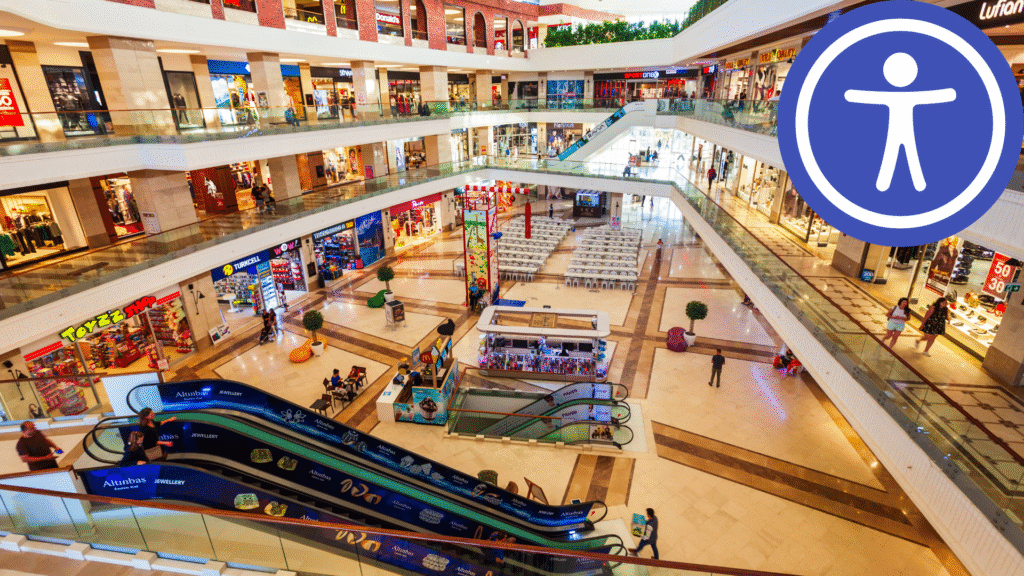Accessibility is no longer a niche concern—it’s a necessity. As Australia moves toward a more inclusive society, shopping centres must adapt to meet the needs of mobility-impaired shoppers. From larger powered wheelchairs to mobility scooters, not every retail space is designed to accommodate the growing variety of assistive technology used today. In 2025, prioritising mobility access is not only a matter of legal compliance, but also a smart business strategy.
The Rising Need for Inclusive Retail
More Australians are living with mobility challenges than ever before. According to the ABS, over 4.4 million people live with a disability, and a significant portion of them experience mobility-related difficulties. As the population ages and the use of mobility devices increases, shopping centres must ensure they cater to these needs.
However, many centres still lack the infrastructure to support smooth navigation for people using scooters, walkers, or power wheelchairs. Some store entrances are narrow, footpaths are uneven, and internal layouts are too cluttered. The result? Shoppers feel excluded, frustrated, and may not return.
Challenges Faced by Mobility-Impaired Shoppers
While accessibility signs and ramps may tick compliance boxes, they often don’t go far enough. Mobility-impaired shoppers face:
- Narrow entryways or aisles that can’t accommodate large scooters or powered wheelchairs
- Lack of automatic doors or ramps that are either too steep or slippery
- Limited or inconvenient accessible parking bays
- Inadequate rest areas or seating
- Shops cluttered with promotional stands, making turning and navigating extremely difficult
- Inaccessible changing rooms or service counters
For people using mobility scooters, even entering the centre from the car park can be a challenge. Once inside, the difficulty of navigating tight retail layouts often makes for a tiring, unpleasant experience. The solution lies in thoughtful design and technology.
Accessibility Is Good Business
In 2025, accessible design isn’t just the ethical thing to do—it’s profitable. Shoppers with mobility needs represent a massive spending power, not just for themselves but for their families and carers as well.
When a centre is inclusive, it draws a wider audience and builds a loyal customer base. Accessibility improvements often lead to:
- Longer visit durations
- Higher spend per visit
- Greater customer satisfaction
- Positive brand perception
- Increased word-of-mouth referrals
A single accessible store can become a go-to spot for entire communities. And with more people using review platforms and social media, being recognised as an inclusive destination can strengthen your brand identity.
What the Law Says (Australian Context)
The Disability Discrimination Act 1992 (DDA) mandates equal access for people with disabilities in public spaces, including shopping centres. Non-compliance can result in complaints, investigations, and financial penalties. But beyond legal risk, shopping centres have a social responsibility to accommodate all users.
Initiatives like Accessibility Equipment Standards for Major Malls (AESMM 2025) are pushing for clearer benchmarks to improve retail inclusivity across Australia. Participating centres are expected to modernise their infrastructure, layout, and service practices in line with universal design principles.
How to Improve Mobility Access in Your Shopping Centre
If you’re a shopping centre owner, manager, or urban planner, here are concrete actions to enhance mobility access:
1. Rethink Your Entrances
Make sure entrances are wide, flat, and equipped with automatic sliding doors. Replace heavy manual doors or narrow thresholds that limit scooter or wheelchair entry.
Tip: Incorporate level access from the parking area to the entrance, with tactile and visual guides for safety.
2. Invest in Spacious Layouts
Design aisles and walkways with ample turning radius for larger mobility devices. Remove unnecessary displays or fixtures that narrow the path. Create rest stops with sturdy seating at regular intervals.
3. Upgrade Flooring and Ramps
Ensure that flooring is non-slip and smooth, and ramps have gentle gradients with handrails on both sides. Avoid sharp transitions between different flooring types that could pose hazards.
4. Install Inclusive Signage
Use large, high-contrast signage with universal symbols. Digital directories with voice activation or touchless functions can assist those with limited hand mobility or vision impairments.
5. Offer Accessible Services and Amenities
- Make fitting rooms and toilets accessible
- Train staff to assist shoppers respectfully and proactively
- Provide mobility-friendly trolleys or rental scooters onsite
- Implement priority queuing systems for those with visible or invisible disabilities
6. Leverage Assistive Technology
Equip your space with tools like powered door openers, voice-activated kiosks, or automatic height-adjustable counters. These are not just futuristic add-ons—they’re essential to creating a smoother, stress-free retail experience.
Looking to upgrade your centre’s accessibility tech? Explore our assistive solutions here.
At Assistive Tech Hub, We Help You Stay Ahead
We work with shopping centres across Australia to improve mobility access using affordable, high-quality assistive solutions. From reliable mobility scooters and power wheelchairs to infrastructure guidance, our team can help you make your space more inclusive.
Whether you’re redesigning your layout or upgrading your existing setup, we offer practical recommendations and products tested for real-life shopping conditions. Our goal is to help you welcome more shoppers and improve their experience every step of the way.
Conclusion: Mobility Access is a Must in 2025
Inclusive shopping is the future of retail—and mobility access is at its core. By addressing common challenges and integrating practical solutions, shopping centres can evolve into welcoming, accessible destinations for all.
Don’t wait for regulations to catch up. Make the change now.
Contact us to make your centre mobility-ready and Explore our mobility scooter range or power wheelchair solutions
FAQs
Q: What makes a shopping centre mobility-friendly?
A mobility-friendly centre includes wide aisles, accessible entrances, non-slip ramps, clear signage, and available assistive services like seating, scooters, or trained staff.
Q: Do I have to make every store in my mall compliant?
Yes. The DDA requires all publicly accessible areas, including individual shops, to provide equal access to people with disabilities.
Q: How do I know if my current layout is accessible enough?
You can start with an accessibility audit or consultation. Assistive Tech Hub offers personalised advice and solutions tailored to your facility.
Q: Are there affordable mobility devices for public spaces?
Absolutely. We offer a range of budget-friendly, durable scooters and powered wheelchairs designed for daily public use.



